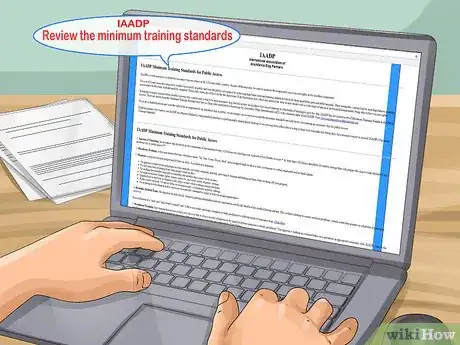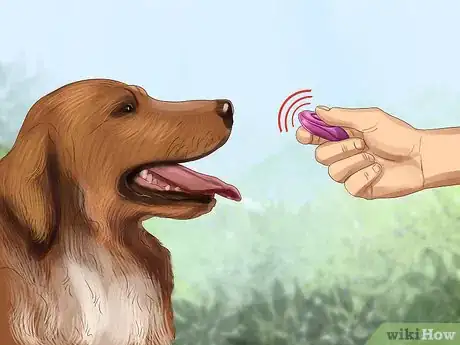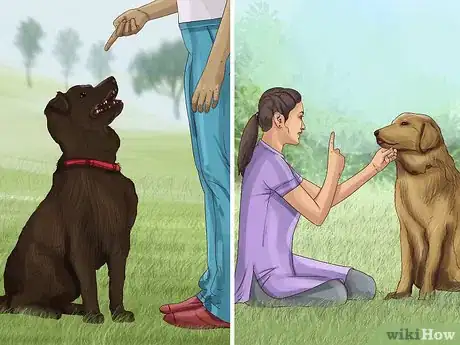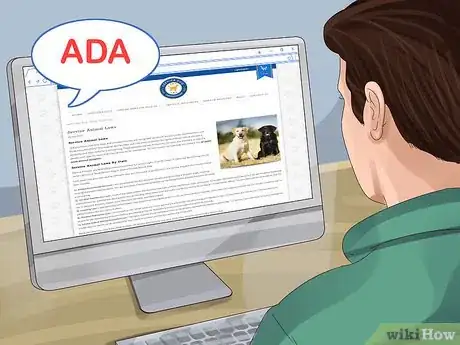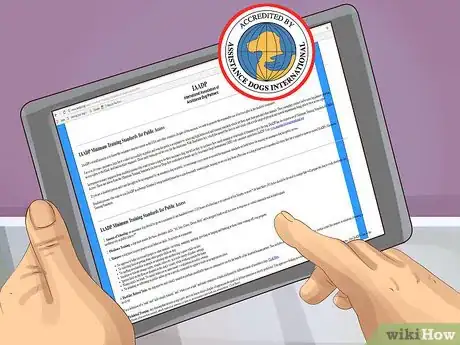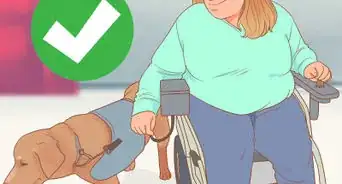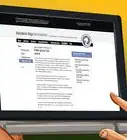This article was written by Jennifer Mueller, JD. Jennifer Mueller is an in-house legal expert at wikiHow. Jennifer reviews, fact-checks, and evaluates wikiHow's legal content to ensure thoroughness and accuracy. She received her JD from Indiana University Maurer School of Law in 2006.
There are 9 references cited in this article, which can be found at the bottom of the page.
This article has been viewed 22,336 times.
Under the Americans with Disabilities Act (ADA), service dogs working in the US are allowed to accompany their handlers virtually anywhere as long as their handler remains in control of the dog. The law prohibits anyone from requiring specific service dog registration as a condition for having the dog with you. However, having physical proof of completing training milestones can be helpful in some cases.[1]
Steps
Training Your Dog
-
1Evaluate your dog's temperament. Any dog must have a particular set of qualities to have potential as a good service dog. Your dog may be a relatively obedient and well-behaved pet, but that still doesn't mean it's cut out to be a service dog.[2]
- Generally speaking, service dogs should be calm, friendly dogs that are quick learners and can retain information. You want your service dog to be alert and attentive, but not one that reacts to every trigger or chases every distraction.
- If your dog seems willing to please and tends to follow you around a lot, it might make a good service dog.
- Service dogs can be any breed. Some breeds, such as Golden Retrievers, make good service dogs because of breed characteristics that give them the right temperament.
-
2Review the minimum training standards. There isn't a universal regulating body for service dogs, nor are there any legal requirements for training. One organization, the International Association of Assistance Dog Partners (IAADP), has developed minimum standards to guide handlers who want to self-train their dogs.[3]
- You can read the minimum training standards developed by the IAADP at http://www.iaadp.org/iaadp-minimum-training-standards-for-public-access.html. The website has additional resources you can use in your training programs, including sample daily training logs you can use.
- The IAADP recommends at least 120 hours of training over a period of 6 months or more. At least 30 hours of training should be spent in public places, where your service dog can practice focusing and ignoring distractions.
- Training for specific disability-related tasks can take longer than the minimum 120 hours. The more tasks you expect your service dog to do, the more time you will have to devote to training.
Advertisement -
3Get assistance from a reputable trainer. Given the expense of having a service dog professionally trained, mainly handlers decide to train their own dogs. However, even if you're self-training your dog, you can still benefit from advice and assistance from an experienced trainer.[4]
- A good place to start is with a trainer accredited by Assistance Dogs International (ADI). Trainers go through a rigorous process to become accredited, and are assessed regularly to ensure they continue to maintain the organization's high standards.[5]
- You can search for ADI accredited members near you on the ADI website at https://www.assistancedogsinternational.org/members/programs-search/.
-
4Start with clicker conditioning. Because a clicker only takes 1/10th of a second to complete, it marks the exact behavior you want your dog to repeat. This level of exactness will make the rest of your training go more smoothly, since you can communicate more clearly with your dog.[6]
- First condition your dog to respond to the clicker. Click the clicker 20 times in a row, giving your dog a treat after each click. When you click it the 21st time, watch how your dog reacts. If your dog is looking for a treat, give it one. If it isn't, do another 20 clicks until the dog starts automatically expecting a treat when it hears the clicker.
- Once your dog is clicker-trained, make sure you always give it a treat whenever you click. If you stop giving treats every time, the conditioning will unravel because your dog won't know whether to expect a treat when it hears the click.
-
5Use tether training to teach your dog to settle. Service dogs are expected to remain close by their handlers. They're also expected to spend a lot of the time sitting or laying down in a calm state, even when there are many exciting or distracting things going on around them.[7]
- Get a short tether, and attach it to an immovable object. When your dog is tethered, it has enough room to change positions, but not enough room to get up or run away. Tethering also teaches your dog impulse control.
- Start by putting your dog on the tether for short periods of time, gradually increasing the length of time the dog is tethered. Never leave your dog alone when it is tethered.
-
6Teach your dog basic commands. Any service dog should respond correctly to basic dog commands such as "sit," "heel," and "stay." You can teach your dog these commands yourself using the clicker and treats, or you can take your dog to a general obedience training school.[8]
- Once your dog starts responding to the command correctly on a reliable basis, you no longer need to use the clicker. You should still treat your dog occasionally, so it knows it's doing what's expected of it.
-
7Practice walking nicely on a leash. Walking close by your side without pulling or jerking on the leash is one of the most important skills a service dog can possess.[9]
- You can start leash training when your dog is just a puppy. Put the leash on the puppy's collar and walk short distances inside the house.
- As your dog becomes more proficient with leash walking, introduce more and more distractions that might cause it to lose focus. Reward your dog when it doesn't respond to distractions.
- ADA regulations specify that your dog should be in your control at all times. If your dog cannot walk calmly on a leash in a public place, it is not in your control and should not be taken out in public.[10]
-
8Work on focus in public places. When you're out in public, your service dog should be focused on you at all times, ignoring all distractions. Spend many hours with your dog in different types of public places that may have different hazards and distractions to break your dog's focus.[11]
- You may want to spend the bulk of your time training in public going to places you frequent. Your dog should be most familiar with these places at different times of the day and night.
- Start your public training by going to places when they aren't particularly busy and there are likely to be fewer distractions. When your dog is able to maintain focus, go at a busier time.
Licensing Your Dog
-
1Check dog license laws where you live. Your service dog must comply with all local regular licensing and registration regulations. This typically includes getting vaccinated for rabies and wearing dog tags.[12]
- Some cities have banned certain dog breeds in the belief that those breeds represent a threat to the health and safety of the community. Service dogs must be exempted from those bans.
- Under the ADA, it is illegal to require mandatory registration of service dogs. However, some local communities may offer special service dog tags in addition to regular dog tags.
- If your community offers service dog tags or special registration, participation is voluntary. However, registration may provide important benefits. For example, if your service dog was registered, first responders would know to look for your dog during an emergency evacuation.
-
2Have an accredited training organization certify your dog. Accredited training organizations may administer the Assistance Dogs International (ADI) Public Access test. If your service dog can pass this grueling test, it is considered among the elite service dogs in the world.[13]
- The ADI itself does not test or certify dogs, but many accredited organizations do. You can find an accredited organization near you by visiting http://www.iaadp.org/iaadp-minimum-training-standards-for-public-access.html.
- More than half of the service dogs trained by accredited professional trainers cannot pass this test, so don't be disappointed if your dog doesn't make the grade.
- If the organization offering the test allows it, videotape your dog completing the tasks. You never know when it might come in handy later on.
-
3Give your dog the AKC Canine Good Citizen (CGC) test. This test is another way to document the effort you've put into training a self-trained service dog. It's typically easier to find an obedience center that offers this test than it is to find one that offers the ADI Public Access test.[14]
- Some obedience centers only offer the test to dogs who complete the 6-week canine good citizen class. However, there are many that offer the test separately for people with self-trained dogs who want the credential.
- If your dog passes the test, you'll receive a certificate signed by an AKC evaluator memorializing the accomplishment.
- As with the Public Access test, it's a good idea to videotape your dog completing the test, if the obedience center allows it.
-
4Consider registering your dog with the United States Service Dog Registry (USSDR). Registration with the USSR is voluntary, not required. You may find it's something you want to do; some people feel that when you register your dog with the organization you are committing to hold yourself (and your dog) to a higher standard of training and behavior.[15]
- When you register your dog with the USSDR, you will receive a unique identification number. You can create a profile for your dog (like a service dog resumé) that lists your dog's training, certifications, and achievements. Anyone who looks up your dog's number will be able to view this information.
- The number can be helpful if you find yourself around someone who is nervous about your service dog. The information on your profile could help put them at ease that your dog is well-trained and would never pose a danger to anyone.
Warnings
- This article covers the treatment of service animals under U.S. law. If you live in another country, speak to an attorney with experience in disability law to learn what you need to do to register your dog as a service animal.⧼thumbs_response⧽
- You can buy service animal certification papers online. However, these papers do not give you or your dog any greater rights, and are not by themselves proof that your dog is a service animal.[19]⧼thumbs_response⧽
- Buying service dog certification papers online and trying to pass off your pet as a service dog, whether to save money on pet fees or just to have your furry friend with you, is a federal crime.[20]⧼thumbs_response⧽
- Emotional support and therapy animals are not the same as service animals, and they are not protected by the ADA. They are protected under some state and local laws.[21]⧼thumbs_response⧽
References
- ↑ https://www.ada.gov/regs2010/service_animal_qa.html
- ↑ http://www.akc.org/expert-advice/training/advanced-training/service-dog-training-101/
- ↑ http://www.iaadp.org/iaadp-minimum-training-standards-for-public-access.html
- ↑ http://www.akc.org/expert-advice/training/advanced-training/service-dog-training-101/
- ↑ https://www.assistancedogsinternational.org/standards/adi-standards/
- ↑ https://www.anythingpawsable.com/first-five-skills-service-dog-in-training/
- ↑ https://www.anythingpawsable.com/first-five-skills-service-dog-in-training/
- ↑ https://www.anythingpawsable.com/first-five-skills-service-dog-in-training/
- ↑ https://www.anythingpawsable.com/first-five-skills-service-dog-in-training/
- ↑ https://www.ada.gov/regs2010/service_animal_qa.html
- ↑ https://www.anythingpawsable.com/things-service-dogs-public/
- ↑ https://www.ada.gov/regs2010/service_animal_qa.html
- ↑ http://www.akc.org/expert-advice/training/advanced-training/service-dog-training-101/
- ↑ http://www.iaadp.org/iaadp-minimum-training-standards-for-public-access.html
- ↑ https://www.usservicedogregistry.org/
- ↑ https://www.ada.gov/regs2010/service_animal_qa.html
- ↑ https://www.usservicedogregistry.org/terms_training.php
- ↑ https://www.anythingpawsable.com/ada-access-challenge-service-dog/
- ↑ https://www.ada.gov/regs2010/service_animal_qa.html
- ↑ http://www.akc.org/expert-advice/training/advanced-training/service-dog-training-101/
- ↑ https://www.ada.gov/regs2010/service_animal_qa.html

